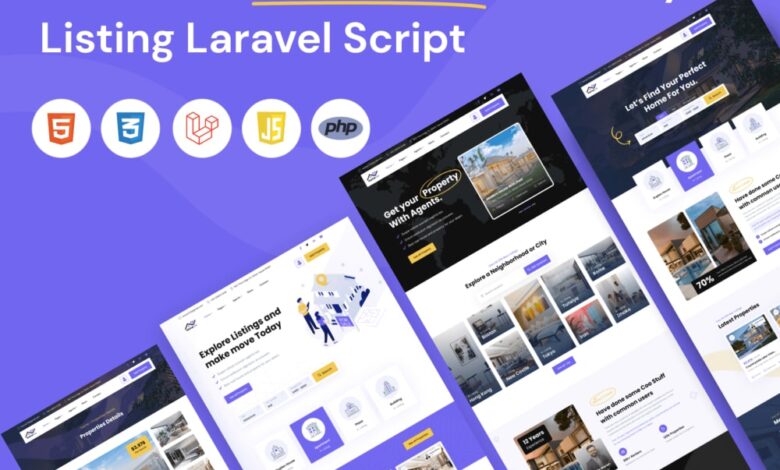The Ultimate Guide to Using the Property Listing App Laravel for Real Estate Professionals
The Ultimate Guide to Using the Property Listing App Laravel for Real Estate Professionals

Laravel, known for its elegant syntax and powerful features, has emerged as a popular choice for building property listing apps. This comprehensive guide will walk you through the process of utilizing Laravel to its fullest potential, empowering you to create a seamless user experience for your clients.
Understanding the Property Listing App Laravel
Laravel is a PHP web application framework that provides developers with a clean and elegant syntax, making it easier to build robust and scalable web applications. Its popularity in the web development community has made it a go-to framework for building property listing apps in the real estate industry.
One of the key advantages of using Laravel for your property listing app is its powerful and intuitive ORM (Object-Relational Mapping) system. This allows you to map database tables to PHP classes, making it easier to work with your property listings and perform complex queries.
In addition, Laravel provides a wide range of built-in features and libraries that can significantly streamline the development process. From authentication and authorization to caching and routing, Laravel takes care of the repetitive tasks, allowing you to focus on building a feature-rich and user-friendly property listing app.
Key Features of the Property Listing App Laravel
When it comes to building a property listing app, it’s important to consider the key features that will enhance the user experience and make your app stand out from the competition. Fortunately, Laravel provides a wide range of features and libraries that can help you achieve just that.
One of the key features of Laravel is its powerful routing system. With Laravel’s routing, you can easily define the URLs and routes for your property listing app, making it easy for users to navigate through your app and access the information they need.
Another important feature is Laravel’s templating engine, which allows you to separate the presentation logic from the business logic. This makes it easier to create dynamic and responsive property listing pages that adapt to different screen sizes and devices.
Additionally, Laravel provides robust support for database management, allowing you to easily create, update, and delete property listings. With Laravel’s migration system, you can easily manage changes to your database schema and keep your property listings up to date.
How to Set Up and Customize the Property Listing App Laravell
Setting up and customizing your property listing app with Laravel is a straightforward process. To get started, you’ll need to install Laravel on your development environment. Laravel provides a detailed installation guide on its official website, which you can follow step by step.
Once you have Laravel installed, you can start customizing your property listing app by modifying the default configuration files provided by Laravel. These files allow you to configure various aspects of your app, such as the database connection, caching system, and authentication settings.
In addition to customizing the configuration files, you can also create your own routes, controllers, and views to tailor your property listing app to your specific needs. Laravel follows the MVC (Model-View-Controller) architectural pattern, which promotes separation of concerns and makes it easier to maintain and extend your app in the future.
To make your property listing app visually appealing, you can leverage Laravel’s built-in templating engine, Blade. Blade provides a clean and intuitive syntax for creating dynamic and reusable templates, allowing you to easily generate HTML markup for your property listing pages.
Optimizing Your Property Listings for Search Engines
To ensure that your property listings are easily discoverable by potential buyers, it’s important to optimize them for search engines. Fortunately, Laravel provides several tools and techniques that can help you improve the SEO (Search Engine Optimization) of your property listing app.
One of the first steps in optimizing your property listings is to ensure that each listing has a unique and descriptive title. The title should accurately describe the property and include relevant keywords that potential buyers might use when searching for properties online.
In addition to the title, you should also optimize the meta tags of your property listing pages. Meta tags provide a brief description of the content on the page and are often displayed in search engine results. By writing compelling and keyword-rich meta tags, you can increase the click-through rate to your property listings.
Another important aspect of SEO is the URL structure of your property listing pages. Laravel provides a flexible routing system that allows you to define custom URLs for your property listings. By including relevant keywords in the URLs, you can improve the ranking of your property listings in search engine results.
Integrating Social Media Marketing into Your Property Listing App Laravel
In today’s digital age, social media has become an essential tool for marketing and promoting your property listings. With Laravel, you can easily integrate social media sharing buttons into your property listing app, allowing users to share their favorite listings with their friends and followers.
One way to integrate social media into your property listing app is by using Laravel’s built-in socialite package. Socialite provides a simple and elegant way to authenticate users with popular social media platforms such as Facebook, Twitter, and Google. By allowing users to sign in with their social media accounts, you can encourage them to share their favorite listings with their social networks.
Another way to leverage social media marketing is by integrating social media feeds into your property listing app. With Laravel, you can easily fetch and display the latest posts from your social media accounts, allowing users to stay updated with your latest property listings and promotions.
Additionally, you can use Laravel’s built-in queue system to schedule and automate social media posts. By creating a queue of social media posts, you can ensure a consistent and timely presence on social media, increasing the visibility of your property listings and attracting more potential buyers.
Best Practices for Managing and Organizing Your Property Listings
Effective management and organization of your property listings are crucial for maintaining a professional and efficient property listing app. Laravel provides several best practices and tools that can help you streamline the management process and ensure that your property listings are well-organized.
One best practice is to use Laravel’s built-in validation system to validate the data submitted by users when creating or updating property listings. By setting up validation rules, you can ensure that the data entered by users meets the required criteria, preventing errors and inconsistencies in your property listings.
Another best practice is to leverage Laravel’s built-in caching system to optimize the performance of your property listing app. By caching frequently accessed data, such as property details and images, you can reduce the load on your database and provide a faster and more responsive user experience.
To keep your property listings organized, you can use Laravel’s eloquent ORM to define relationships between different models. For example, you can define a one-to-many relationship between a user model and their property listings, making it easier to retrieve and manage the listings associated with a specific user.
Leveraging Analytics and Data to Optimize Your Real Estate Marketing Efforts
Analytics and data play a crucial role in optimizing your real estate marketing efforts. With Laravel, you can easily integrate popular analytics tools such as Google Analytics into your property listing app, allowing you to track and analyze the performance of your listings.
By analyzing the data provided by analytics tools, you can gain valuable insights into the behavior and preferences of your users. For example, you can track the number of views, inquiries, and conversions for each property listing, allowing you to identify the most popular listings and optimize your marketing efforts accordingly.
Laravel also provides tools for collecting and analyzing user feedback. By integrating a feedback form into your property listing app, you can collect valuable feedback from users and use it to improve the user experience and address any issues or concerns.
In addition to analytics and user feedback, you can also leverage Laravel’s built-in logging system to track and monitor the performance of your property listing app. By logging important events and errors, you can quickly identify and resolve any issues that may arise, ensuring a smooth user experience.
Advanced Tips and Tricks for Maximizing the Potential of the Property Listing App Laravel
Once you have mastered the basics of using Laravel for your property listing app, there are several advanced tips and tricks that can help you maximize its potential and take your app to the next level.
One advanced technique is to use Laravel’s event system to implement real-time updates for your property listings. By defining events and listeners, you can notify users in real-time when a new property listing is added or when there are updates to their favorite listings.
Another advanced tip is to leverage Laravel’s queue system to process time-consuming tasks in the background. For example, you can use queues to resize and optimize images uploaded by users, ensuring a fast and responsive user experience.
Additionally, you can take advantage of Laravel’s package ecosystem to extend the functionality of your property listing app. Laravel has a vibrant community of developers who have created a wide range of packages that can add new features and integrations to your app. From search filters and maps to secure payment gateways, there is a package for almost every requirement.
Conclusion: The Future of Real Estate Marketing with Laravel
In conclusion, Laravel is a powerful and versatile framework that can revolutionize the way real estate professionals market and manage their property listings. By leveraging its elegant syntax, powerful features, and extensive ecosystem, you can create a property listing app that provides a seamless user experience and helps you stay ahead of the competition.
Whether you’re a seasoned real estate professional or a newbie in the industry, this ultimate guide has provided you with the knowledge and skills necessary to harness the power of Laravel and take your property listings to the next level. From setting up and customizing your app to optimizing your listings for search engines and integrating social media marketing, you now have the tools to elevate your business and provide an exceptional experience for your clients.
The future of real estate marketing is bright with Laravel. As technology continues to evolve, so do the opportunities for innovation and growth in the real estate industry. By staying up to date with the latest trends and leveraging the power of Laravel, you can position yourself as a leader in the field and reap the rewards of a successful and thriving real estate business. So what are you waiting for?




Thanks for sharing. I read many of your blog posts, cool, your blog is very good.